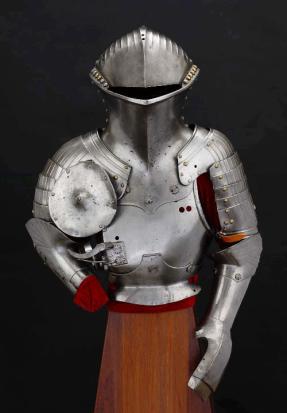
Nuremberg jousting armor, about 1500
Tournaments originated around the time of the First Crusade as a way for the newly emerged class of knights to practice their skills in mounted combat. Today, jousting has become a familiar feature of Renaissance fairs; the historical sport has been brought into the forefront of popular culture through the 2001 film A Knight’s Tale; and two reality-TV programs are now showcasing the modern revival of sport jousting (National Geographic’s Knights of Mayhem and the History Channel’s Full Metal Jousting).
On October 21, 2011, the Higgins Armory Museum in Worcester unveiled its special exhibit Extreme Sport: Jousting Then and Now. The exhibit traces the story of jousting and other tournament sports from the Middle Ages to the present, integrating artifacts with multiple media in order to bring these medieval sports to life, while allowing visitors to approach the material from diverse points of access and perspectives. In particular, Extreme Sport features a series of interactive stations, supported by a $5000 grant from MassHumanities, that are designed to broaden the exhibit’s accessibility and appeal, especially for young people.

Historical lances above the “heft-a-lance” interactive.
Tournaments included a variety of combat sports, of which jousting ultimately emerged as the most popular. Tournament armor was never made in great quantities, and surviving examples are extremely rare. The Higgins Armory, the only dedicated museum of armor in the western hemisphere, actually owns a significant number of these remarkable artifacts, some of which are here on public display for the first time. Featured treasures in this exhibit include:
- A rare “rental armor” worn by socially ambitious townsmen in Renaissance Nuremberg, still bearing deep gouges in the steel from the impact of opposing lances.
- Weapons and armor from the free-for-all “Bridge Game” played in the Italian city of Pisa from the late Middle Ages into the 1800s.
- Lances and armor from the 1839 Eglinton Tournament organized by Sir Walter Scott.
- Reinforcing plates added to medieval suits of armor to protect against the impact of the opponent’s lance.
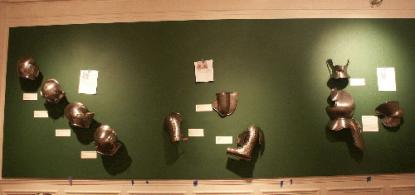
Armor and reinforces for various tournament sports.
Various parts of the exhibit focus on specialized armor for jousting and other tournaments sports; reinforcing pieces that provided extra protection for these dangerous games; horse equipment, including saddles, bits, stirrups, spurs, and armor; lances; and equipment from the tumultuous “Bridge Game” (Gioco del Ponte) played by townsmen of the Italian city of Pisa.
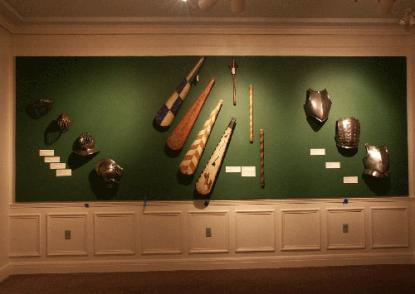
Equipment for the Gioco del Ponte.
A major goal of the exhibit is to breathe life into these artifacts by giving visitors a feel for the power of jousting as it was practiced in the Middle Ages, and for the excitement of the revived sport in the 21st century. This is particularly evident in the section of the exhibit that juxtaposes medieval and modern tournaments, with medieval images of tournaments mingling with photos from modern jousts; biographies of medieval jousters; perspectives from contestants involved in modern jousting (and from their horses!); and a video showing action at the modern American Tournament of the Phoenix.
A centerpiece of the show is the “Virtual Joust,” a digital interactive supported by a $50,000 grant from the National Endowment for the Humanities. Using an infrared-rigged lance stub as an interface, visitors can try their hand at the sport of jousting in a virtual environment modeled on historical sources. The museum is currently developing an online component for the Virtual Joust that will make the game accessible to a worldwide audience, as well as providing background information to allow players to explore more deeply the historical realities behind the digital game.
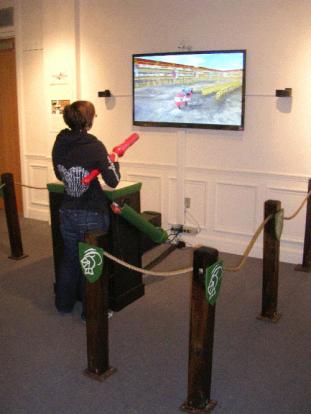
The Virtual Joust.
There is a more historical information about jousting than can effectively be conveyed in text signage to museum visitors, so the three interactives supported by MassHumanities play a crucial role in providing interactivity that offers more explicit learning opportunities. These interactives approach the material through different media, allowing the exhibit to reach the broadest range of learning styles:
- For a digital learning experience, the grant supported a touch-screen miniquiz that poses various true-or-false questions about tournaments. The quiz includes a “show me more” option that gives visitors clues to the questions in the form of visual and textual primary-source material.
- For a tactile experience, the exhibit includes a hands-on “heft-a-lance” interactive. Here visitors can get a hands-on feel for how a lance really worked—something difficult to understand from the surviving artifacts, which are only part of the full apparatus of a medieval lance.
- A combined tactile and reading experience is provided by an oversized flip-book that allows visitors to explore the rules of jousting and the different forms of tournament sports, with particular attention to the role of jousting equipment and the artifacts on display. Modern explanations are here integrated with primary-source images and texts to allow the visitors make a closer connection to the past and to place the objects in their historical context.
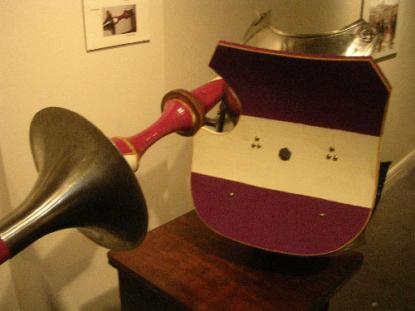
“Heft-a-lance.” The round steel “vamplate” at left protects the jouster’s hand. The leather ring around the lance butts against the steel “lance-rest” (partially visible here projecting from the surface of the breastplate)—this helps the jouster control the 12-foot lance. The wooden shield serves as a target for the opponent. The leather and wooden portions of this equipment have not generally survived.
Extreme Sport will be on display through 2012.


